The herb basil is a superstar in kitchens all around the world. From pesto to pizzas and everything in between, basil adds a fresh, peppery taste that can’t be matched. But it’s not all about taste; basil’s also got some pretty impressive health benefits. It’s packed with vitamins and antioxidants, making it a great addition to your diet for more reasons than one. It’s super easy to grow, whether you’ve got a big garden or just a small pot on a sunny windowsill. So, whether you’re a food lover or just looking to add a green thumb to your skills, basil’s a great place to start. Let’s dive into the world of basil and discover all the amazing things it has to offer.
The Basics of Basil
Basil, Ocimum basilicum, is an aromatic culinary herb known for its flavor and aroma. It’s a member of the mint family and can be found in many parts of the world. Basil has been used in cooking since ancient times and remains popular due to its versatility.
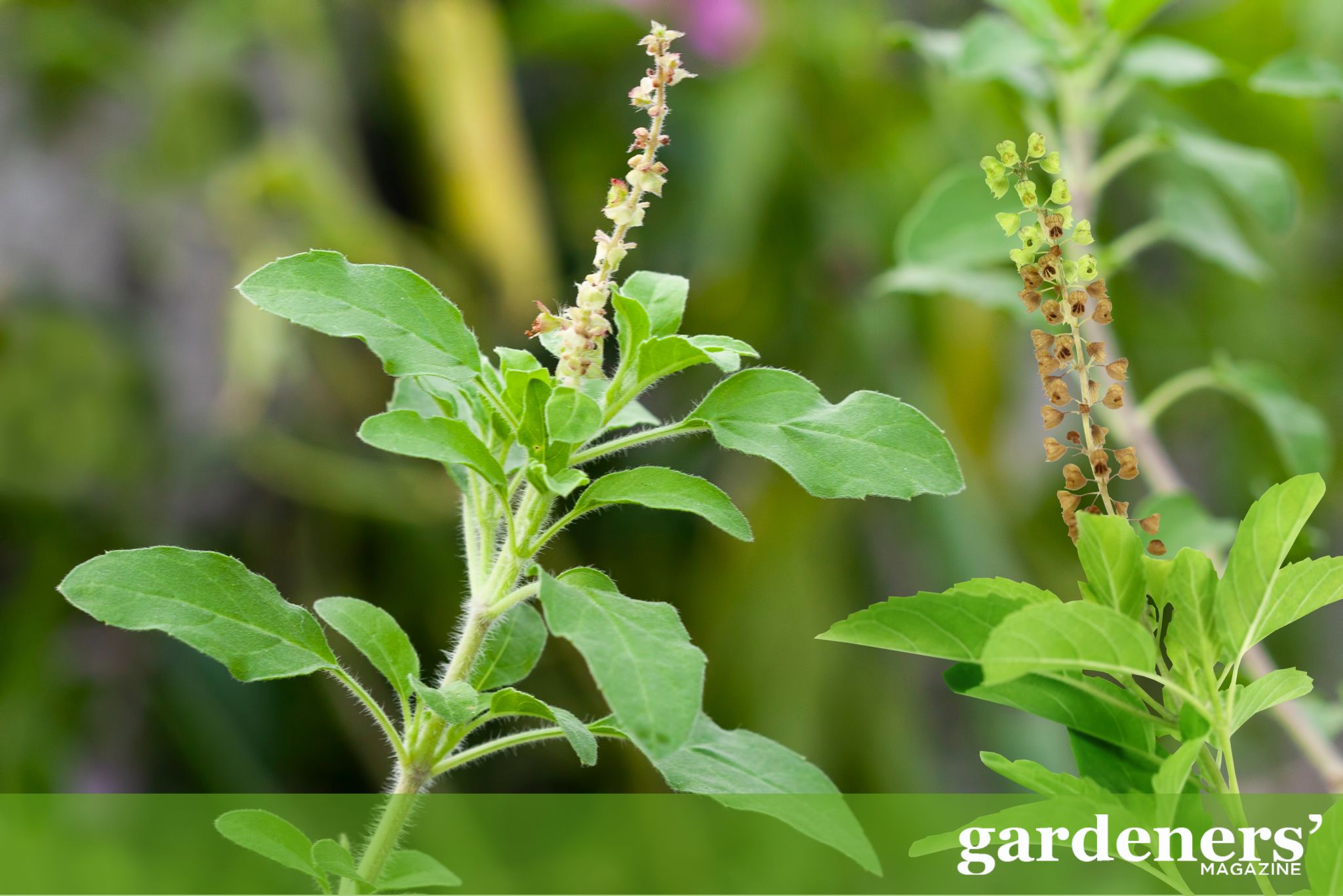
Basil is an annual herb that’s native to India, Africa, and parts of Asia. Its leaves are dark green, oval-shaped, and widely used in Mediterranean cuisine. It has a slightly peppery or licorice-like flavor and can be used fresh or dried. Basil pairs especially well with tomatoes, garlic, onions, fish, and poultry.
Types of Basil
There are different types of basil available on the market today. The most popular varieties include:
- Sweet Basil (Ocimum basilicum) is perhaps the most common variety, often used in Italian cooking for its fresh, peppery taste that complements dishes like pesto and caprese salad beautifully. It features broad, bright green leaves with a smooth texture.
- Thai Basil (Ocimum basilicum var. thyrsiflora), with its hint of licorice flavor, is a staple in Asian cuisine, adding depth to spicy curries and stir-fries. It is recognized by its smaller, narrower leaves and a purplish stem, that grows more upright.
- Holy Basil (Ocimum tenuiflorum), or Tulsi, is highly regarded in India for both its spicy, clove-like flavor and its medicinal properties, often used in teas and traditional remedies. It has green or purple leaves that are slightly hairy.
- Lemon Basil (Ocimum × citriodorum) stands out for its citrusy notes, making it a refreshing addition to salads, seafood dishes, and beverages. It has narrow, light green leaves.
Across different cultures, basil is not just a culinary herb but also a plant with significant cultural and health-related value. Its versatility and range of flavors make it a beloved ingredient in kitchens worldwide, showcasing its ability to bring dishes to life with just a few leaves.
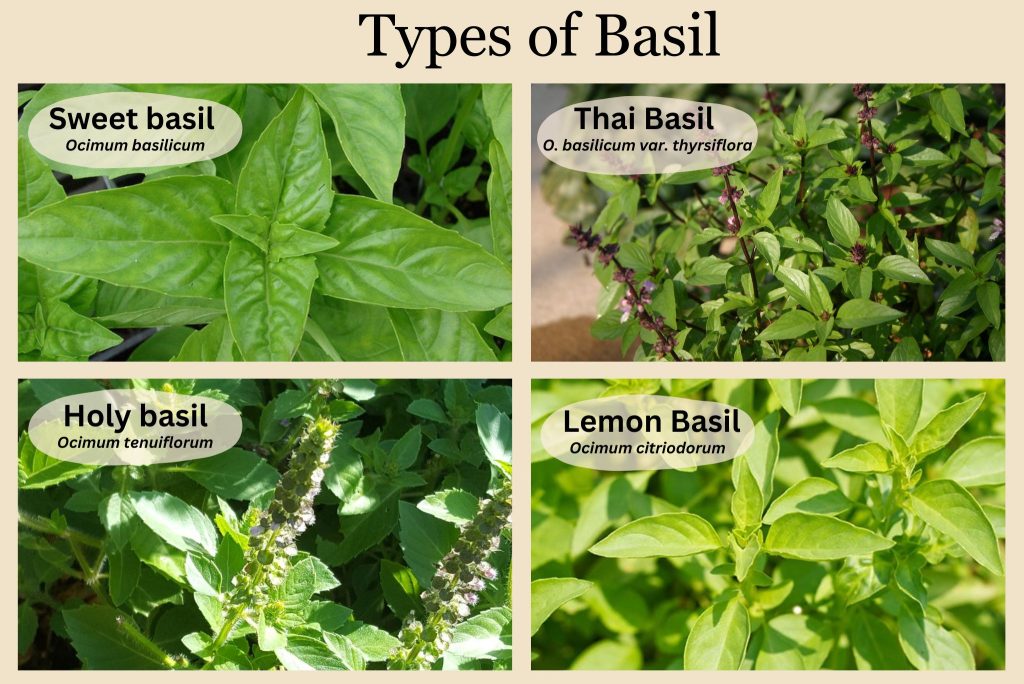
History And Origin Of Basil
Basil has been cultivated for centuries and is native to India, Africa, and Asia. It was introduced to Europe in the 1500s and quickly became a staple ingredient in many culinary dishes. The herb has long been used as a medicinal plant by Ancient Greeks and Romans, who believed it had healing properties.
Health Benefits Of Basil
Basil is full of antioxidants that are beneficial to your overall health. These antioxidants can help fight off free radicals, which can harm your cells, leading to premature aging. Basil is also high in vitamins A and K and minerals like calcium, magnesium, and iron, which are essential for healthy bones and muscles. Additionally, basil has been linked to improved digestion, lower cholesterol levels, and better blood sugar control.
Uses of Basil
Basil is highly valued for its culinary uses and can be used in various dishes such as salads, sauces, pasta, soups, and casseroles. It’s also popular in teas and herbal remedies due to its potential health benefits. Additionally, basil oil same as rosemary essential oil and lemongrass essential oil has been used in aromatherapy for its calming effects on the mind and body.
How To Grow Basil
Growing basil is relatively easy, and the rewards are abundant. Here is a step-by-step guide on how to do it :
To start, you’ll need to find a warm, sunny spot in your garden for the plant to thrive. You can also sow basil seeds indoors if you choose. It is best to start with quality soil with good drainage and slightly acidic (around pH 6).
Once you have chosen a location for your basil plants, prepare the soil by tilling it deeply with a hoe or turning it over with a shovel. Remove any weeds, rocks, or debris from the area and amend the soil if necessary.
When planting basil outdoors, plant two or three seeds in each hole about an inch deep. If starting indoors, gently press two or three seeds into each cell of your seed tray. Keep the soil consistently moist but not soggy, and wait for the seeds to germinate in two to three weeks.
Once the young plants have grown their first true leaves, thin out extras so that only one or two remain per hole, and transfer the seedlings outdoors into individual pots or directly into your garden. Plant each seedling about a foot apart and keep them well-watered at least twice a week.
Planting Basil Indoors: If planting indoors, ensure you provide enough light for your basil by using artificial lights or a grow light. Basil does not like cold temperatures—it should be kept at about 70 degrees Fahrenheit for optimal growth. You can also use a potting mix specifically for herbs to ensure successful growth indoors.
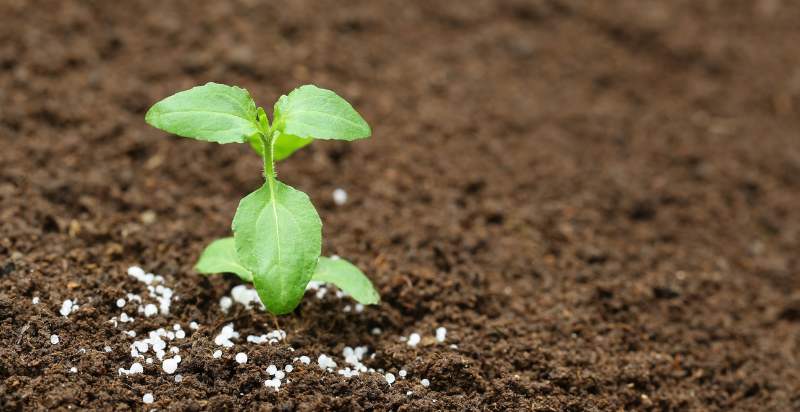
How To Care For The Basil Plant
Here are some tips on how to grow and maintain a healthy basil plant:
Watering
Basil plants need consistent water to stay healthy. Water them regularly but make sure to keep the soil neat and dry. You should also avoid using tap water if possible, as it contains chlorine, which can harm plants. Consider using rainwater or distilled water instead.
Light
Basil loves plenty of sunshine, so place it in a spot where it will get at least 6 hours of sunlight daily. You can supplement with artificial lights or move the plant outdoors during summer as long as temperatures don’t reach extreme highs.
Fertilizer
Basil plants need nutrients to stay healthy. Use an all-purpose fertilizer, and follow instructions carefully when applying the product. Also, always avoid over-fertilizing your basil plants, as this can lead to nutrient burn and damage to the plant.
Pruning
Regular pruning is necessary for basil plants as it promotes better air circulation, which reduces disease pressure. Prune by pinching off leaves that are beginning to look yellow or brown. This will also encourage new growth and help keep your basil plant looking its best.
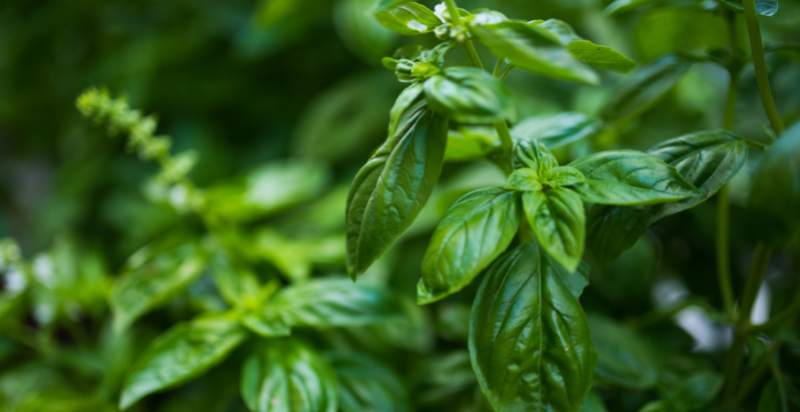
Prevention From Pests And Diseases
Basil is susceptible to several diseases and pests, including aphids, whiteflies, basil downy mildew, root rot, and caterpillars. To prevent these issues from occurring in the first place, it’s important to practice good growing habits. Here are a few tips for preventing disease and pest problems:
- Plant basil in well-drained soil with plenty of organic matter.
- Water plants at their base rather than spraying them with water from above.
- Avoid planting basil near other plants that may be prone to the same problems, such as other members of the mint family or nightshade vegetables (tomatoes).
- Keep weeds away from your basil plants, so they don’t compete for water and nutrients.
- Remove any diseased or dead leaves from the plant.
- Rotate the location of your basil plants yearly to avoid diseases that may spread from one season to the next.
- Inspect your plants regularly for signs of pests and diseases, such as aphids or wilting leaves.
- If a pest infestation does occur, use natural pest control methods, such as introducing beneficial insects that prey on the pests or using soapy water sprays.
- Prune basil plants regularly to encourage new growth and reduce humidity levels around the plants. This helps prevent fungal diseases like downy mildew.
Troubleshooting Common Issues
Growing basil can sometimes come with its set of challenges, but don’t worry, most issues can be easily resolved with a bit of know-how.
Here is a list of some of the common problems with basil plants and ways to troubleshoot them:
- Wilting: This often happens due to either too much water or not enough. Checking the soil before watering can help you strike the right balance, ensuring the plant’s roots are moist but not waterlogged.
- Brown leaves: This indicates a sunburn from too much direct sunlight or could be a sign of nutrient deficiency. Moving your plant to a spot with filtered light and ensuring the soil is rich in nutrients can often remedy this.
Prevention is key, so ensuring good air circulation around your plants and practicing crop rotation can help keep your basil healthy. With these tips, you’ll be well-equipped to tackle any issues that come your way, ensuring a bountiful basil harvest.
Harvesting Basil
You can start harvesting your basil leaves as soon as the plant has grown 4 inches tall. Make sure to harvest in the morning before the sun gets too hot to preserve the herb’s flavor. Also, don’t remove more than a third of the leaves at once so that you don’t damage the plant and leave enough for it to produce more leaves in future harvests.
Trimming basil is also important for the health of the plant and to encourage more growth. When you trim, focus on cutting the stem just above a pair of leaves. This technique encourages the plant to become bushier, leading to more leaves for future harvesting. Regular trimming prevents the basil from flowering too early, which can cause the leaves to lose some of their flavors. Remember, the goal is to keep the plant producing leaves, not flowers, for as long as possible.
With these tips on caring for a basil plant, you should have no problem growing and maintaining a healthy one! Be sure to follow all instructions carefully to enjoy its delicious flavor and medicinal benefits for many years.
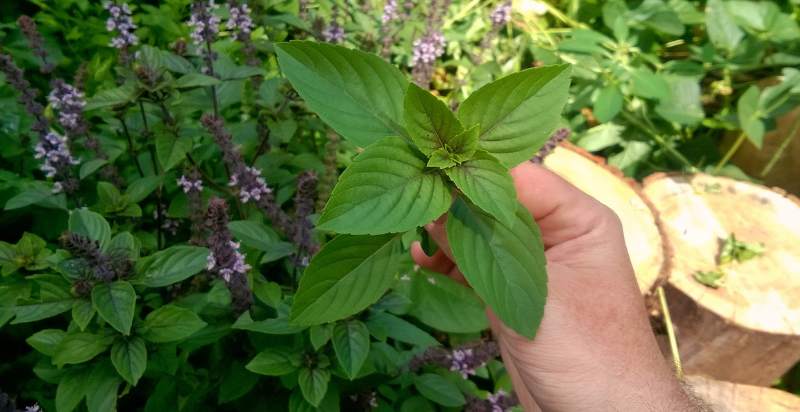
Companion Planting
Companion planting is a gardening practice that pairs certain plants together for mutual benefits, and basil is a champion in this arena, especially when planted alongside tomatoes. The reason behind this perfect pairing is multifaceted. Firstly, basil is believed to improve the growth of tomato plants, possibly by repelling harmful pests or by attracting beneficial insects. This protective effect can lead to healthier, more robust tomato plants.
Moreover, basil enhances the flavor of tomatoes when they grow side by side. Gardeners often report that tomatoes taste sweeter and more flavorful when basil is their neighbor. This might be due to subtle changes in the soil chemistry or simply the close proximity of the two plants influencing each other’s development.
Basil doesn’t just benefit tomatoes; it’s also a great companion for peppers, lettuce, and asparagus, among others. It’s thought to repel mosquitoes and flies, making it a useful plant to have in any garden. By incorporating basil into your garden, you’re not just adding a versatile herb to your culinary arsenal; you’re also employing a natural way to enhance the health and taste of your other plants.
How To Store Homegrown Basils?
To keep homegrown basils fresh and flavorful, it is ideal for storing them in the refrigerator. Ensure you wash and dry your homegrown basil thoroughly before storing them away. Place the basil leaves in a sealed zip-lock bag or container with a damp paper towel. This will help keep moisture around the herbs and prevent them from drying. Be sure to change the paper towel every few days and check your herb’s condition regularly.
If they start to get limp or turn brown, discard them immediately as they have gone bad. You can also freeze homegrown basil later by either blanching and freezing individual leaves or using an ice cube tray with a bit of water to create frozen cubes for storage. When ready to use, thaw and add to your favorite dishes. Enjoy!
How To Use Basils?
Basil is a versatile herb that can be used in many dishes, both savory and sweet. Whether adding it to your favorite sauce, making pesto, or even trying out a basil-infused dessert, there are endless possibilities when it comes to cooking with basil.
Try chopping fresh homegrown basil leaves and adding them to salads, sandwiches, pasta, or omelets for a burst of flavor. You can also infuse vinegar or oils with the herb for an extra kick of flavor. You can also make herbal teas by steeping the leaves in hot water and adding lemon juice, honey, and other herbs like mint for a refreshing beverage.
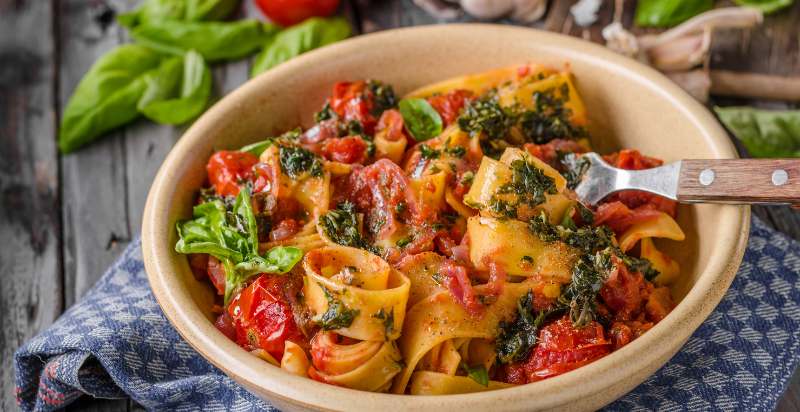
What Are The Risks of Consuming Basil?
Basil is generally safe to eat in the amounts normally found in food. However, consuming large amounts of basil may cause minor side effects such as nausea, vomiting, and diarrhea. Excessive consumption of basil may also interact with certain medications and supplements, so it’s best to always check with your doctor before using it medicinally. Additionally, some people may be allergic to basil, which can lead to skin reactions or more serious symptoms if consumed in large quantities. Therefore, it is important to use caution when adding it to your diet.
With all these tips in mind, you are now ready to enjoy the health benefits and delicious taste of homegrown basils! So go ahead and start growing your herbs today for a fresh supply that you can always use. Bon appétit!
Conclusion
Growing basil is one of those simple pleasures in gardening that brings immense joy and flavor to your life. The taste of basil, freshly picked, is incomparable to anything you buy at the store. It’s not just about the flavor; basil is packed with health benefits, from vitamins to antioxidants, making it a powerhouse of nutrition right at your fingertips.
Starting your own basil plant is easy and rewarding. Basil finds its way to thrive, asking for little more than sunlight and some water. The satisfaction of using your home-grown herbs in cooking is unmatched. So, why not give it a try? Share your basil-growing journey and inspire others. Let’s spread the green and the flavor!
- Everything You Wanted to Know About Red Tamarillos - June 2, 2025
- A Guide to Tulips: Everything You Need to Know & More… - June 2, 2025
- Guanabana: Description, Flavor, Benefits, And Uses - May 27, 2025

23 thoughts on “How To Plant, Grow, And Harvest Basil”
Comments are closed.